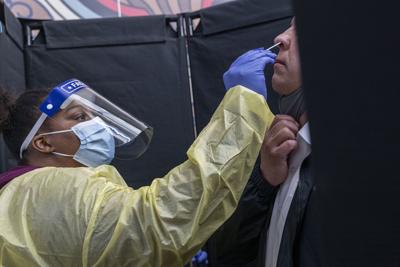
When to test for Covid-19
It is often good to address your suspicions of Covid-19 by taking a test, although when you do it makes a difference.
If you are feeling symptoms, now is the time to take a test, El-Sayed said.
For those who have been exposed but aren’t feeling symptoms, there is a possibility that the virus hasn’t developed enough to show up on a rapid test, he explained. In those cases, it is best to wait five days after exposure before testing and to remain on the lookout, according to the CDC.
“Just because you get a negative test doesn’t necessarily mean it’s not Covid,” El-Sayed said. “The best approach is to test and then maybe test again in 12 to 24 hours, and if you get two negatives, you can be more certain that it’s not.”
Whether it is Covid-19 or the common cold, it has always been a good idea to isolate while you fight a viral illness, he said. It has become even more important with the risk of spread increasing with Covid-19.
What to do if your child starts sniffling
Looking ahead to the return to school after the winter break, the US is at a point where people need to treat cold or flu symptoms the same as Covid-19, Combs said.
When a family comes into her emergency room with a child that has sniffles and a sore throat and asks what it is, she is honest: She can’t know for sure without a test, said Combs.
Children are experiencing Omicron much in the same way adults are in that the symptoms are much more wide-ranging and often milder, like a cold, she said.
Getting a flu shot for your child is important to reduce the chance of adding another virus to the mix, Combs said. Children under 5-years-old are still waiting on vaccine approval from the US Food and Drug Administration, but those older can get vaccinated to reduce the risk of spread and serious disease.
As they go back to a school environment, testing is going to be essential to protecting against outbreaks, Combs said.
“If you’re looking to be really careful, if you’re looking at a child going back to a school environment is to spread to other people, I would say really the only way to know is taking that test,” Combs said.
The good news is we know how to manage infections when children return to school, Combs said. When it isn’t clear if your child was exposed or if their test is still pending, protocols like masking, sanitizing, distancing and reducing indoor gatherings are still believed to be effective in reducing spread, she added.
And know that advice may evolve as time goes on, El-Sayed cautioned.
“It’s changing quickly. We’re learning a lot more,” he said. “Omicorn is a variant we’ve really only known for about a month.” (CNN)






461524 854739dude this just inspired a post of my own, thanks 659924
629640 428269Great information, much better still to find out your blog that has an excellent layout. Nicely done 220386